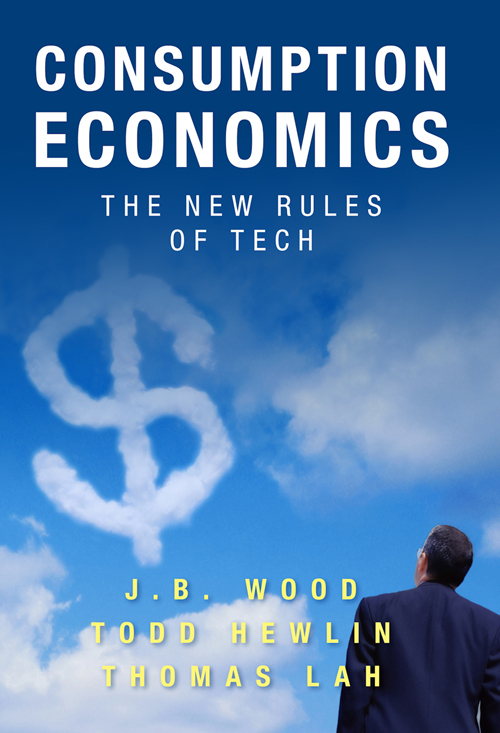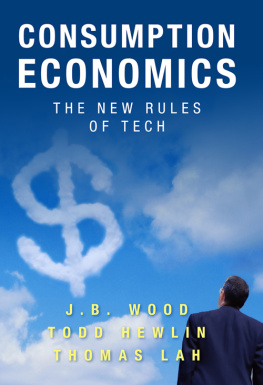J. B. Wood - Consumption Economics
Here you can read online J. B. Wood - Consumption Economics full text of the book (entire story) in english for free. Download pdf and epub, get meaning, cover and reviews about this ebook. year: 2011, publisher: Point B Inc, genre: Business. Description of the work, (preface) as well as reviews are available. Best literature library LitArk.com created for fans of good reading and offers a wide selection of genres:
Romance novel
Science fiction
Adventure
Detective
Science
History
Home and family
Prose
Art
Politics
Computer
Non-fiction
Religion
Business
Children
Humor
Choose a favorite category and find really read worthwhile books. Enjoy immersion in the world of imagination, feel the emotions of the characters or learn something new for yourself, make an fascinating discovery.
Consumption Economics: summary, description and annotation
We offer to read an annotation, description, summary or preface (depends on what the author of the book "Consumption Economics" wrote himself). If you haven't found the necessary information about the book — write in the comments, we will try to find it.
Consumption Economics — read online for free the complete book (whole text) full work
Below is the text of the book, divided by pages. System saving the place of the last page read, allows you to conveniently read the book "Consumption Economics" online for free, without having to search again every time where you left off. Put a bookmark, and you can go to the page where you finished reading at any time.
Font size:
Interval:
Bookmark:

Todd Hewlin
Thomas Lah
Copyright 2011
ISBN: 978-0-9842130-3-0
LCCN: 2011917022
All rights reserved. No part of this book may be reproduced or transmitted in any form or by any means, electronic or mechanical, including photocopying, recording, or by information storage and retrieval systems, without the written permission of the publisher, except by a reviewer who may quote brief passages in a review. Printed in the United States of America.
By Geoffrey Moore
Author of Crossing the Chasm, Inside the Tornado, Dealing with Darwin, and Escape Velocity
A S BUSINESS CATEGORIES EVOLVE AND MATURE, THEY TEND TO bifurcate into two business architectures: one specializing in complex systems, the other in volume operations. Prior to this split, only the complex systems model thrives, focusing on institutional customers, syndicating responsibility for the system across an ecosystem of vendors, partners, and the customers themselves. Because of the cost and complexity of these demands, there is no place for consumers or small businesses in this model, and even midsize businesses can find themselves challenged.
This has been the case for enterprise-class IT systems throughout the course of my life. But as J.B.,Todd, and Thomas make clear in this book, it will no longer be the case going forward. The rise of the volume operations IT model, initially confined to simplified consumer transactions, has now breached the levees protecting the complex systems enclaves. Riding a wave of as a service business models that stretch from infrastructure as a service to software to platforms to business processes, the volume model is reengineering the landscapeand the profit poolsof enterprise IT worldwide.
Now let me be clear. It is not that the complexity of enterprise IT has gone away. Indeed, if anything, it has increased. But as this book shows, responsibility for managing this complexity is shifting from the customer to the vendor. This has huge implications for vendors, for IT organizations inside the enterprise, and for the business itself in terms of leveraging IT, be it for differentiation, expansion, or productivity.
On the vendor side, the shift from a system to a service orientation fundamentally reshapes the economics of the IT sector, migrating zones of profitability to new roles and new players. Systems vendors, long accustomed to being top dog, now find themselves herded into utility computing platforms that disintermediate their relationships with the end customers. Conversely, customer service teams, traditionally marginalized as cost centers, now have taken center stage as their transactions have become the core of the next-generation offer set.
This direct interaction between the system and the end user enables next-generation IT vendors, in turn, to disintermediate the IT organization, at least in its traditional role as gatekeeper. This is not to say that enterprises no longer need an IT function, but to keep up with the times, IT must shift its focus from building and maintaining systems to shaping the interface between managed services providers and the business processes of their enterprise. The impact of staffing should not be underestimated, as the skill sets required to support the new model are quite different from ones used in the old model.
Finally, as vendors and IT organizations are responding to this massively disruptive turn of events, business executives and department managers also must come to the table with a new mindset. IT as a service dramatically lowers the barrier to entry for every enterprise. If yours does not take advantage of this new freedom, you will find yourself falling behind your competitors who do. Never has it been easier to gain a return from IT spending, and it is critical that organizations leverage this newly released cornucopia of capabilities smartly in order to keep current with an increasingly challenging global economy.
But how do you actually do that? How do vendors and IT organizations and business teams co-evolve to capitalize on this dramatic change? That is the focus of this book. Its authors have worked at the epicenter of this disruption throughout the past decade, and I can think of no one more qualified to frame the new agenda.
So buckle up, for it is bound to be a bumpy ride, and learn from these pros how to negotiate the hairpin turns in your future.
Geoffrey Moore
| 1 | How Good We Had It: |
| The Money-Making Machine Known as High-Tech |
I N SECTOR AFTER SECTOR, THE PROFITABILITY OF SELLING TECH products is shrinking. The total amount of gross profit dollars in some tech product sectors is getting smaller every year. For the first time, most companies no longer seem able to innovate their way around the problem. Price competition is taking a huge toll on product margins not just in consumer sectors like PCs, but also in traditionally profitable enterprise segments like networking and software. Its not because tech companies cant innovate anymore, but because tech customers can barely use the complex technology they already own. They have unused features and licenses, excess capacity, and stable systems that serve their basic needs, so why buy more unless its cheaper? This is not the path to profitable growth. It is the path to commoditization, and it is forcing companies to change what business theyre in just to maintain margins. Hardware companies are jumping to services and software. Software companies are making their profits off of maintenance contracts, not selling software.
As an industry, we face a growing gap between what our products are capable of doing and what our customers actually do with them. This may be the true gating factor in the growth of tech industry profits and its not a problem that more features will cure. Failure to close this gap means future revenue growth that is anemic, unprofitable, or both. In the new economics of the cloud, driving usage is even more critical since nearly all the revenue will be based on consumption, and switching costs will be low for disgruntled customers. The cloud as it is currently envisioned is a tricky thing. On the one hand, it could be the rapid draining of the profit pool for high-techa relentless drive for cheaper and cheaper versions of standard functionality. At the Technology Services Industry Association (TSIA), we believe it could also enable a unique ability to fight commoditization. This is what this book is about. However, before we can look to the future, we need to take a look at how we got where we are today.
Technology purchase decisions have always been based on an assessment of risk and reward. If the reward was truly compelling, customers would take the riskspay a high asking price, pay it all up front, put up with lots of frustrations, lots of complexity, even risk failure. Why would a buyer enter into such a lopsided agreement? Its simple: Tech offers were that compelling. Not just compelling, but Wow!-compelling. After all, Wow!-compelling offers are what high-tech companies specialize in. Its what VCs look for, what boards of directors and financial analysts reward, what R&D folks live for, and what salespeople want to sell.
For decades our offers have compelled corporations to buy complex and sophisticated hardware, software, networks, and services. While the investment risks to the buyers were significant, they gladly placed their bets because of the huge opportunity for value creation. Successful IT systems promised to dramatically increase revenues, cut costs, create competitive advantage, improve customer service, or boost employee productivity. These were rewards worth taking real risk for, even if it meant that the customer shoulders far more of it than the tech seller does.
Font size:
Interval:
Bookmark:
Similar books «Consumption Economics»
Look at similar books to Consumption Economics. We have selected literature similar in name and meaning in the hope of providing readers with more options to find new, interesting, not yet read works.
Discussion, reviews of the book Consumption Economics and just readers' own opinions. Leave your comments, write what you think about the work, its meaning or the main characters. Specify what exactly you liked and what you didn't like, and why you think so.












